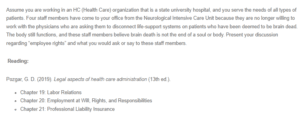Euthanasia and Employee Insubordination
The debate on the legalization of euthanasia, as well as assisted suicide, has a wide array of participants, including the general public, politicians, scholars in health and ethics law, and physicians. It is conflictual, and participants are often poorly informed despite the importance of the issue. It is critical that healthcare practitioners are not categorized as those who are poorly informed (Flegel, 2010). The term ‘right to die’ is used in debates on euthanasia to propose that there exists a right for infliction of death. Death to the human body is inherent, inexorably, and vulnerable to aging; death can be temporarily delayed or can be accelerated but should never be thwarted(Math & Chaturvedi, 2012). Physicians, including the one in this case, often look after the sick to a point where nothing is left undone, which can impact the patient’s health or ease of life. When a patient, even those in the NICU, is afflicted with incurable disorders, physicians use all means to cherish them and make their lives as comfortable as they possibly can. However, if a patient has torturing, lingering pain and has no hope of ever recovering from the illness, or in the case of NICU patients, are on life support, the physician can request the parents or kin to the patient permission to switch off the machine. Patients who are subjected to euthanasia are unable to proceed with life businesses, are a burden to themselves and their kin, and have, in all respects, outlived themselves (Emanuel et al., 2016). It is inhumane to let a patient cling to a disease that is deep-rooted in the false hope of living a fruitful life afterward. A physician assists such a patient to relieve themselves of the pain and torture. In this case, the nurses should view euthanasia as a way of setting the NICU patients’ souls and spirits freedom to live away from pain and torture. According to Danyliv & Oneill (2015), the nurses should also view it as a way for the patient’s parents and kin to find closure to unending agony over their lifeless loved ones as well as a way to curtail unnecessary increasing hospital bills, yet the outcome of the patient is already defined and irreversible.
Every workplace should have a policy that deals with employee insubordination. Although it may not always be in place to discipline or fire an insubordinate employee, it can be used in defending the actions of the employer in a court of law. Insubordination occurs when an employee willfully disregards or disobeys the directive of a legitimate superior (Chullen et al., 2010). As a worker at the healthcare facility, I will make the four employees aware of the consequences of insubordination and that it is unacceptable in the organization. I will proceed to readout the policy to the said employees and remind them that they signed the employment contract binding them to adhere to the policies, rules, and regulations of the organization.
Once I am done explaining the two aspects, euthanasia and insubordination, I will organize training for the nurses (Plump, 2010). It is critical that nursing staff understand the implications of retaining a patient on life-support both to the patient, the kin, and to the hospital, and even the impact that such a patient has on the nursing staff’s emotional and psychological well-being. Additionally, I will remind the nursing staff that their employment is on an ‘at will’ basis and that they are free to resign. If they choose to stay, then they will need to take the training sessions and request to go through the hospital’s HR policies to avoid any future misunderstandings.
References
Chullen, C. L., Dunford, B. B., Angermeier, I., Boss, R. W., & Boss, A. D. (2010). Minimizing deviant behavior in healthcare organizations: The effects of supportive leadership and job design. Journal of Healthcare Management, 55(6), 381-397.
Danyliv, A., & O’Neill, C. (2015). Attitudes towards legalising physician provided euthanasia in Britain: The role of religion over time. Social Science & Medicine, 128, 52-56.
Emanuel, E. J., Onwuteaka-Philipsen, B. D., Urwin, J. W., & Cohen, J. (2016). Attitudes and practices of euthanasia and physician-assisted suicide in the United States, Canada, and Europe. Jama, 316(1), 79-90.
Flegel, K., & Hébert, P. C. (2010). Time to move on from the euthanasia debate.
Math, S. B., & Chaturvedi, S. K. (2012). Euthanasia: right to life vs right to die. The Indian journal of medical research, 136(6), 899.
Plump, C. M. (2010). Dealing with problem employees: A legal guide for employers. Business Horizons, 53(6), 607-618.
ORDER A PLAGIARISM-FREE PAPER HERE
We’ll write everything from scratch
Question

Euthanasia and Employee Insubordination
Assume you are working in an HC (Health Care) organization that is a state university hospital, and you serve the needs of all types of patients. Four staff members have come to your office from the Neurological Intensive Care Unit because they are no longer willing to work with the physicians who are asking them to disconnect life-support systems on patients who have been deemed to be brain dead. The body still functions, and these staff members believe brain death is not the end of a soul or body. Present your discussion regarding “employee rights” and what you would ask or say to these staff members.
Reading:
Pozgar, G. D. (2019). Legal aspects of health care administration (13th ed.).
- Chapter 19: Labor Relations
- Chapter 20: Employment at Will, Rights, and Responsibilities
- Chapter 21: Professional Liability Insurance

